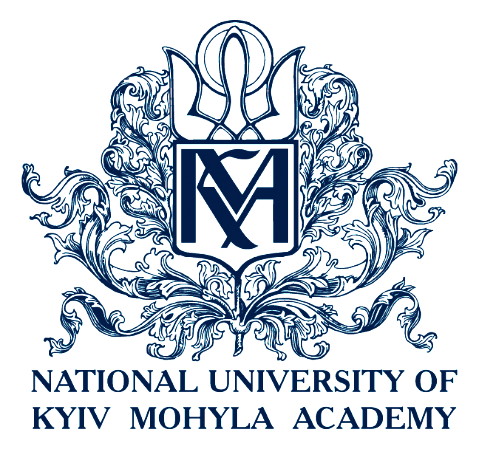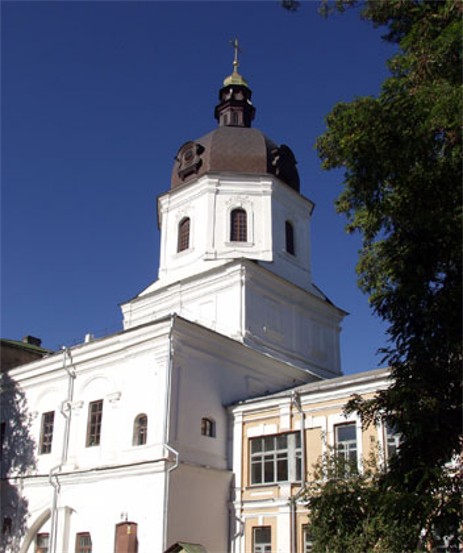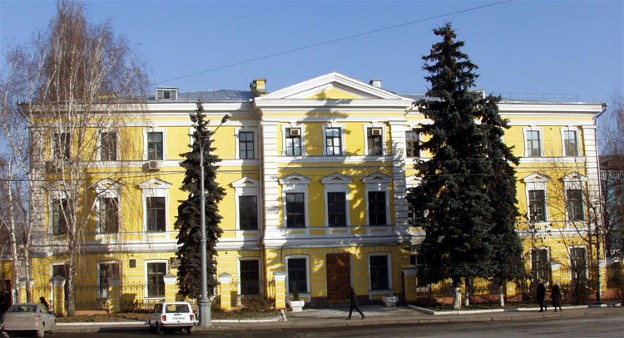National University of Kyiv-Mohyla Academy
National University of Kyiv-Mohyla Academy [Національний університет «Києво-Могилянська академія» or НаУКМА; Natsionalnyi universytet ‘Kyievo-Mohylianska Akademiia’ or NaUKMA]. A national coeducational research university in Kyiv. In 1991, by the ordinance of the head of the Supreme Council of Ukraine, the historical Kyivan Mohyla Academy was officially ‘reestablished’ on its ‘historical territory as an independent institution of higher learning’ under the name University of Kyiv-Mohyla Academy. The university was officially opened in August 1992, with literature specialist Viacheslav Briukhovetsky appointed as its ‘organizing rector.’ Briukhovetsky was the university’s first elected president (acting from 1994 to 2007) and is generally considered to be the institution’s ‘founding father.’ On May 19, 1994, by the decree of President Leonid Kravchuk, the university was granted the status of a national institution of higher learning and it assumed its present name. NaUKMA is a member of the European University Association. The teaching at the university is conducted both in Ukrainian and English.
From its early days, the revived ‘Kyivan Mohyla Academy’ has firmly established itself as a leading university in Ukraine, patterned on North American academic models and generally considered the least corrupt of all classical universities in the country. In contrast to other colleges and universities, NaUKMA admitted students on the basis of rigorous tests, specifically designed to ensure that only the most deserving applicants could enroll. Considerably smaller than most other classical and technical universities, NaUKMA has only about 4,000 (as per 2020; compared, for example, to 26,000 students in the Kyiv National University) and is considered to have had the most selective student body. A number of its graduates went on to become recognized leaders in arts, sciences, business, and politics in Ukraine and abroad (among them is Oleksii Honcharuk, Ukraine’s Prime Minister from August 2019 to March 2020, a graduate of the Kyiv-Mohyla Business School). NaUKMA has been consistently ranked among the best universities in Ukraine, particularly in the fields of the humanities, social sciences, and computer science. In 2012, 2013, and 2019 it was ranked third, fourth, and fifth respectively in the Consolidated Ranking of all Ukrainian universities conducted by the influential educational web portal Osvita.ua.
NaUKMA was the first university in Ukraine to introduce a four-year bachelor degree program (1992) in which students are free to select courses from different fields—a practice adopted from American liberal arts colleges. Among other novelties introduced by NaUKMA have been a 100-point evaluation system (1992); three-term learning process (as opposed to two terms in other Ukrainian institutions of higher learning); innovative two-year Master’s programs (1996); a possibility of majoring in two fields simultaneously (1995); and the Western-patterned Doctoral School (five PhD programs in 2009). Also unique in Ukraine was the creation of the university-affiliated professional schools in collaboration with other European and North American universities and foundations, among them the School of Social Work (1994), the School of Public Health (2004), and the Mohyla School of Journalism (2001) (all of them in the Faculty of Social Sciences and Social Technologies) and the Kyiv-Mohyla Business School (1999) (independent of any faculty). For several years NaUKMA operated two branches, one in Ostroh and another in Mykolaiv. But in the early 2000s these branches began to function as independent institutions of higher learning. In 2000 the Ostroh branch was reorganized into the National University of Ostroh Academy; and in 2002 the Mykolaiv branch became the Mykolaiv State Humanitarian University. The latter was renamed the 2008 and was granted the national university status in 2016; as a result it currently functions as the Petro Mohyla Black Sea National University. NaUKMA continues to supervise a number of secondary schools (kolehiumy) across Ukraine.
NaUKMA has six faculties (the humanities; economic sciences; information technology; law; natural sciences; and social sciences and social technologies); 33 departments; 16 programs for undergraduate students and 23 programs for graduate students; and 34 scholarly centers and laboratories (among them the Center of Membrane Technologies; Laboratory of Genetics and Cellular Biology; Center for Urban Studies; and Center for Psychosocial Rehabilitation).
The NaUKMA scholarly library was built from scratch in 1991, initially based on donations from private individuals. By 1993 it grew to 38,000 volumes. As of January 2020 the library fund consists of 845,152 items, of which 101,607 are electronic titles. This makes the NaUKMA library one of the largest university libraries of Ukraine. The library includes several separate library collections, among them the Victor Kytasty American Library, Tetiana and Omelian Antonovych Library, Omeljan Pritsak Memorial Library, and James Mace Memorial Library. The library also has an open-access electronic archive of the publications by NaUKMA scholars (the institutional repository eKMAIR). The NaUKMA library is among the most active promoters in Ukraine of innovative information technologies.
NaUKMA’s publishing house ‘Kyievo-Mohylians'ka akademiia’ has gained reputation as one of the leading and most prolific academic publishers in Ukraine. Aside from numerous scholarly monographs and textbooks, it publishes a dozen of periodicals, most of them in Ukrainian, some in English. Chief among them is Naukovi zapysky NaUKMA that has been published since 1996 in different thematic series, including biology, economy, history, cultural studies, linguistics, sociology, and others. In 2014, the university began to publish the English-language peer-reviewed Kyiv-Mohyla Humanities Journal (6 vols, 2014–9), the only such scholarly journal in the field of humanities in Ukraine. Another English-language peer-reviewed periodical is Kyiv-Mohyla Law and Politics Journal (5 vols, 2015–9). The Ukrainian-language periodicals include Judaica Ukrainica (8 vols, 2012–9), Kyїvs'ka Akademiia (15 vols, 2004–8), Mova: klasychne-moderne-postmoderne (4 vols, 2014–8), and Magisterium (since 1998) that appears in twelve thematic series and contains primarily the contributions from graduate students. Of non-academic publications the most prominent is Kino-Teatr, Ukraine’s leading magazine devoted to cinema and theater, both Ukrainian and international; it has been published under the auspices of NaUKMA since 1995.
An important cultural and artistic hub since the early 1990s, NaUKMA has been home to a wide variety of art clubs, art galleries, and performing arts companies that gained recognition across Ukraine. For a number of years NaUKMA hosted the George Soros gallery, later transformed into Contemporary Art Center (1995–2009), that played an important role in promoting contemporary art in Ukraine. In 1997–2005 the center was headed by the Polish-born Canadian-Ukrainian curator Jerzy Onuch who helped bring to Kyiv artworks by such internationally acclaimed artists as Andy Warhol, Joseph Beuys, Damien Hirst, and Joseph Kosuth. The NaUKMA film club (Kinoklub, established in 1994) has for years been a unique mainstay on Kyiv’s cultural scene; it has introduced generations of students and Kyiv residents to important works of classical and arthouse cinema. In the 1990s, NaUKMA housed the Kyiv Experimental Theater (founded by Valerii Bilchenko, Iaroslav Chornenky, and Anatolii Petrov) that gained a cult following among Kyiv’s theatergoers for its avant-garde, and award-winning, performances of twentieth-century dramas. NaUKMA’s Center for Arts and Culture serves as a coordinating center for students’ diverse artistic projects and includes an art gallery, the Pochaina choir, a student theater studio, and the film club.
Always known for their social and political activism, NaUKMA students took an active part in mass democratic protest movements, from the protests against the authoritarian rule of President Leonid Kuchma (‘Ukraine without Kuchma’) in 2000–1, to the Orange Revolution in 2004–5 and the Euromaidan Revolution in 2013–4. Several students, graduates, and faculty members have also participated in the Ukrainian-Russian war in the Donbas region since 2014.
Since 1992 the NaUKMA faculty has included many prominent scholars, such as philosophers Serhii Krymsky, Myroslav Popovych, and Anatolii Yermolenko; sociologists Oleksandr Pohorily and Volodymyr Paniotto; historians Mykhailo Kirsenko, Rev. Yurii Mytsyk, and Nataliia Yakovenko; archeologist Mykola Chmykhov; literary scholars Serhii Ivaniuk, Serhii Kvit, Volodymyr Morenets, Solomiia Pavlychko, and Vira Aheieva; political scientists Oleksandr Derhachov and Oleksii Haran; legal scholar Andrii Meleshevych; economist Oleksandr Iastremsky; chemists Mykhailo Bryk and Anatolii Burban; ecologist Vitalii Zamostian; biologists Tamara Ternovska and Serhii Kosterin; physicists Yurii Shymansky [Szymanski] and Petro Holod, and others.
The NaUKMA campus is located in Kyiv’s historical district of Podil and includes nine buildings. The oldest is the so-called Old Academy (Ivan Mazepa) buildings (built in 1704) that were home to the original Kyivan Mohyla Academy in the 18th century. Other important buildings include the New Academy Building built in 1822–5 for the Kyiv Theological Academy and designed by Kyiv’s renowned architect Andrei Melensky.
BIBLIOGRAPHY
Onyshchenko, Ie. Voskresinnia Akademiї: spohady pro vidrodzhennia Kyievo-Mohylians'koї akademiї ta ioho uchasnykiv (Kyiv 2004)
NaUKMA website: https://www.ukma.edu.ua/
Serhiy Bilenky
[This article was written in 2020.]


.jpg)
 buildings with Annunciation Church.jpg)
 buildings.jpg)

.jpg)